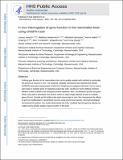| dc.contributor.author | Swiech, Lukasz | |
| dc.contributor.author | Heidenreich, Matthias | |
| dc.contributor.author | Banerjee, Abhishek | |
| dc.contributor.author | Habib, Naomi | |
| dc.contributor.author | Li, Yinqing | |
| dc.contributor.author | Trombetta, John | |
| dc.contributor.author | Sur, Mriganka | |
| dc.contributor.author | Zhang, Feng | |
| dc.date.accessioned | 2016-05-18T18:03:09Z | |
| dc.date.available | 2016-05-18T18:03:09Z | |
| dc.date.issued | 2014-10 | |
| dc.date.submitted | 2014-05 | |
| dc.identifier.issn | 1087-0156 | |
| dc.identifier.issn | 1546-1696 | |
| dc.identifier.uri | http://hdl.handle.net/1721.1/102531 | |
| dc.description.abstract | Probing gene function in the mammalian brain can be greatly assisted with methods to manipulate the genome of neurons in vivo. The clustered, regularly interspaced, short palindromic repeats (CRISPR)-associated endonuclease (Cas)9 from Streptococcus pyogenes (SpCas9) can be used to edit single or multiple genes in replicating eukaryotic cells, resulting in frame-shifting insertion/deletion (indel) mutations and subsequent protein depletion. Here, we delivered SpCas9 and guide RNAs using adeno-associated viral (AAV) vectors to target single (Mecp2) as well as multiple genes (Dnmt1, Dnmt3a and Dnmt3b) in the adult mouse brain in vivo. We characterized the effects of genome modifications in postmitotic neurons using biochemical, genetic, electrophysiological and behavioral readouts. Our results demonstrate that AAV-mediated SpCas9 genome editing can enable reverse genetic studies of gene function in the brain. | en_US |
| dc.description.sponsorship | Foundation for Polish Science | en_US |
| dc.description.sponsorship | Human Frontier Science Program (Strasbourg, France) | en_US |
| dc.description.sponsorship | Massachusetts Institute of Technology. Simons Center for the Social Brain | en_US |
| dc.description.sponsorship | European Molecular Biology Organization (Fellowship) | en_US |
| dc.description.sponsorship | McGovern Institute for Brain Research at MIT (Friends of McGovern Institute Fellowship) | en_US |
| dc.description.sponsorship | National Institutes of Health (U.S.) (Grant R01EY007023) | en_US |
| dc.description.sponsorship | National Institutes of Health (U.S.) (Grant R01MH085802) | en_US |
| dc.description.sponsorship | Simons Foundation | en_US |
| dc.description.sponsorship | National Institute of Mental Health (U.S.) (NIH Director's Pioneer Award 5DP1-MH100706) | en_US |
| dc.description.sponsorship | National Institute of Neurological Disorders and Stroke (U.S.) (NIH Transformative R01 Grant 5R01-NS073124) | en_US |
| dc.description.sponsorship | W. M. Keck Foundation | en_US |
| dc.description.sponsorship | Merkin Foundation | en_US |
| dc.description.sponsorship | Vallee Foundation | en_US |
| dc.description.sponsorship | Damon Runyon Cancer Research Foundation | en_US |
| dc.description.sponsorship | Kinship Foundation. Searle Scholars Program | en_US |
| dc.description.sponsorship | Klarman Family Foundation | en_US |
| dc.description.sponsorship | Klingenstein Foundation | en_US |
| dc.description.sponsorship | Poitras Foundation | en_US |
| dc.language.iso | en_US | |
| dc.publisher | Nature Publishing Group | en_US |
| dc.relation.isversionof | http://dx.doi.org/10.1038/nbt.3055 | en_US |
| dc.rights | Article is made available in accordance with the publisher's policy and may be subject to US copyright law. Please refer to the publisher's site for terms of use. | en_US |
| dc.source | PMC | en_US |
| dc.title | In vivo interrogation of gene function in the mammalian brain using CRISPR-Cas9 | en_US |
| dc.type | Article | en_US |
| dc.identifier.citation | Swiech, Lukasz, Matthias Heidenreich, Abhishek Banerjee, Naomi Habib, Yinqing Li, John Trombetta, Mriganka Sur, and Feng Zhang. “In Vivo Interrogation of Gene Function in the Mammalian Brain Using CRISPR-Cas9.” Nature Biotechnology 33, no. 1 (October 19, 2014): 102–6. | en_US |
| dc.contributor.department | Massachusetts Institute of Technology. Department of Biological Engineering | en_US |
| dc.contributor.department | Massachusetts Institute of Technology. Department of Brain and Cognitive Sciences | en_US |
| dc.contributor.department | Massachusetts Institute of Technology. Department of Electrical Engineering and Computer Science | en_US |
| dc.contributor.department | McGovern Institute for Brain Research at MIT | en_US |
| dc.contributor.department | Picower Institute for Learning and Memory | en_US |
| dc.contributor.mitauthor | Swiech, Lukasz | en_US |
| dc.contributor.mitauthor | Heidenreich, Matthias | en_US |
| dc.contributor.mitauthor | Habib, Naomi | en_US |
| dc.contributor.mitauthor | Li, Yinqing | en_US |
| dc.contributor.mitauthor | Zhang, Feng | en_US |
| dc.contributor.mitauthor | Banerjee, Abhishek | en_US |
| dc.contributor.mitauthor | Sur, Mriganka | en_US |
| dc.relation.journal | Nature Biotechnology | en_US |
| dc.eprint.version | Author's final manuscript | en_US |
| dc.type.uri | http://purl.org/eprint/type/JournalArticle | en_US |
| eprint.status | http://purl.org/eprint/status/PeerReviewed | en_US |
| dspace.orderedauthors | Swiech, Lukasz; Heidenreich, Matthias; Banerjee, Abhishek; Habib, Naomi; Li, Yinqing; Trombetta, John; Sur, Mriganka; Zhang, Feng | en_US |
| dspace.embargo.terms | N | en_US |
| dc.identifier.orcid | https://orcid.org/0000-0003-2782-2509 | |
| dc.identifier.orcid | https://orcid.org/0000-0003-2442-5671 | |
| dc.identifier.orcid | https://orcid.org/0000-0001-6683-5498 | |
| mit.license | PUBLISHER_POLICY | en_US |
| mit.metadata.status | Complete | |
